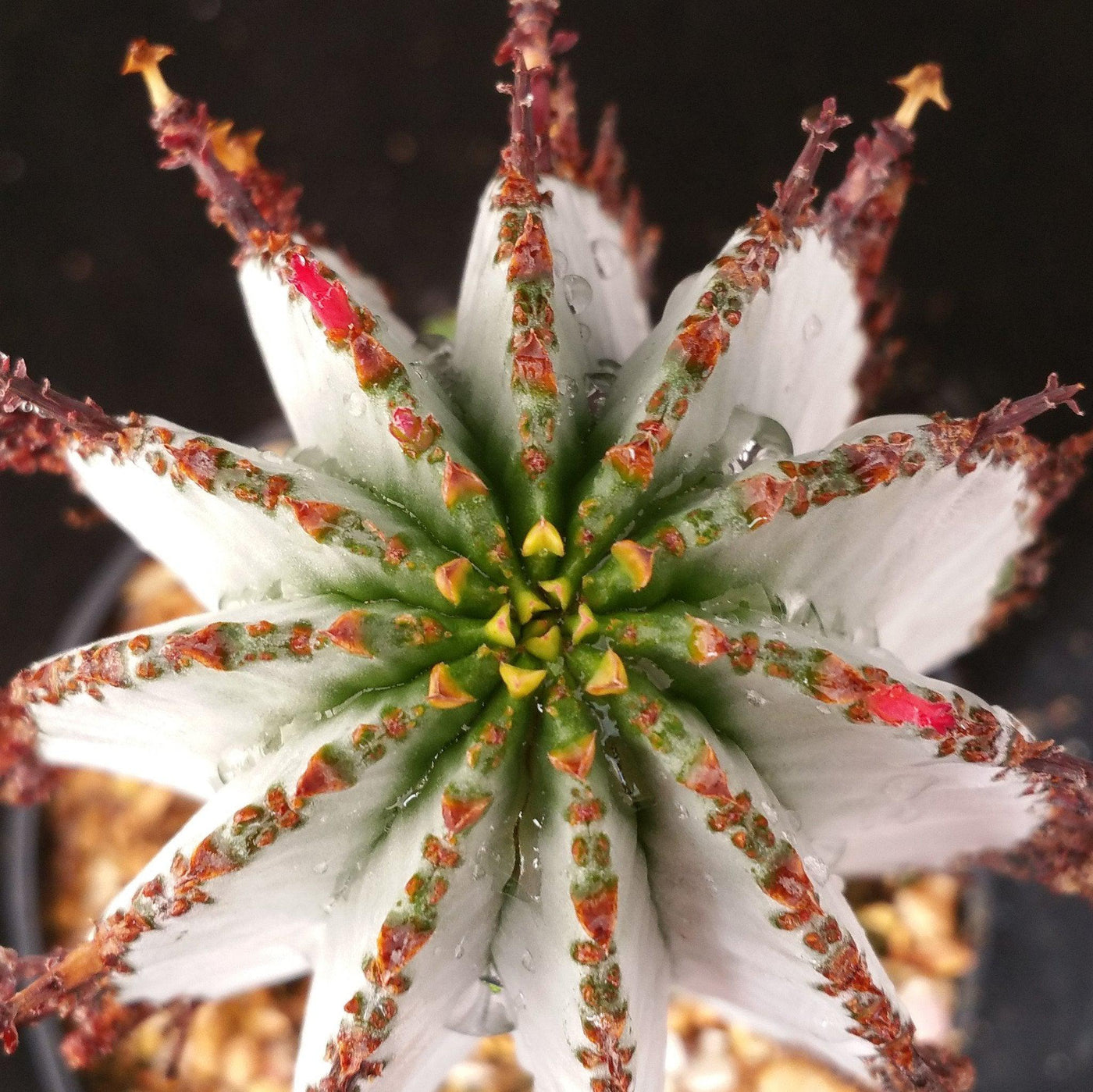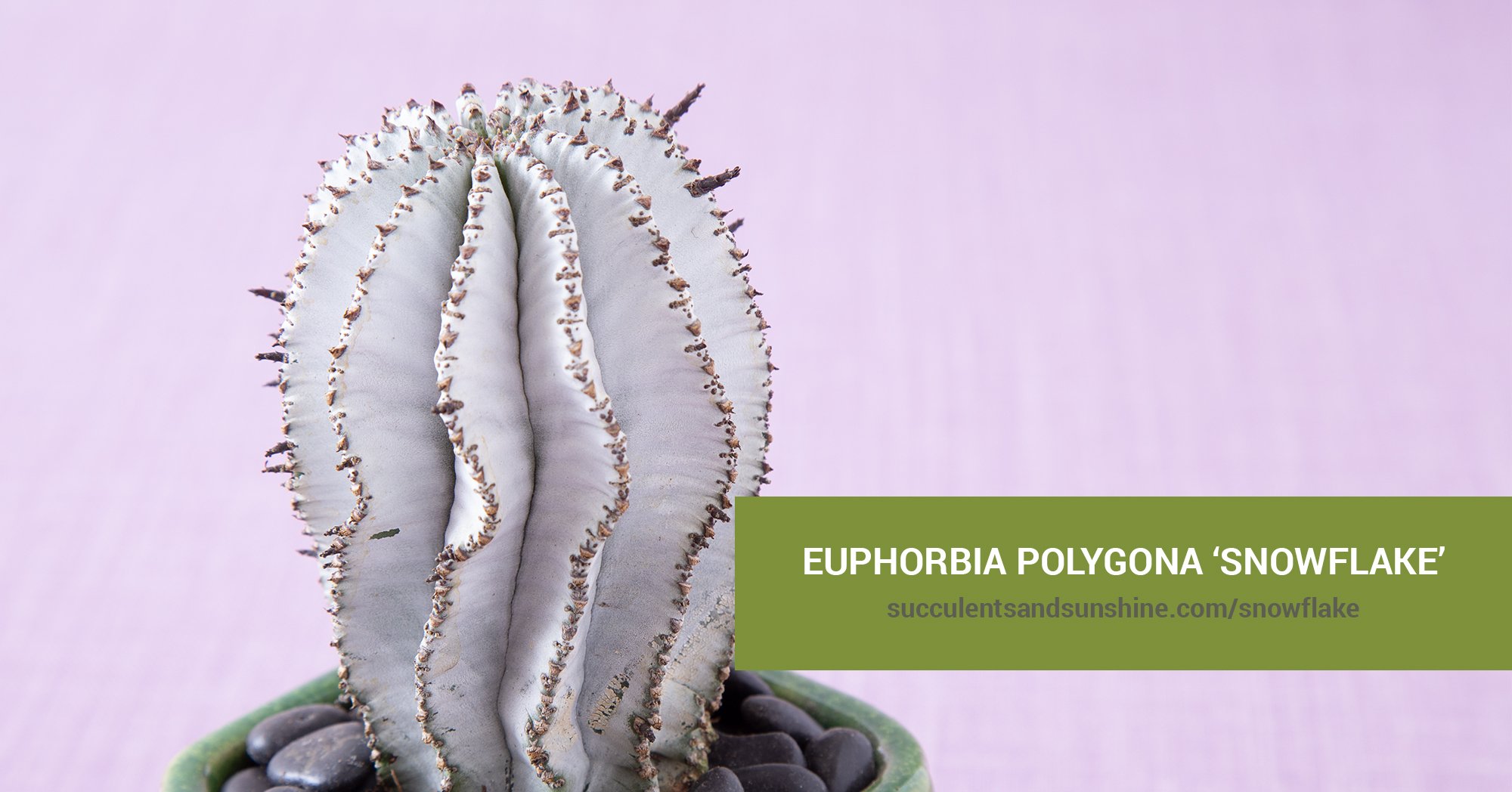This tall, white-colored cactus has crinkled edges and dark thorns. As it matures, the ribs may be either straight or wavy. In the late spring and summer, vivid purple blooms can be seen on the plant.
Table of Contents
Care and Propagation Information
Euphorbia polygona ‘Snowflake’ is a great choice for gardeners looking to add a splash of diversity to their collections. However, caution should be taken when dealing with this succulent, as its sap is poisonous and can cause skin irritation.
Watering
Euphorbia polygona ‘Snowflake’ should be watered according to the “soak and dry” method, meaning the soil should be allowed to become completely dry between waterings.
Where to Plant
If you live in a place with cold weather, it is best to keep ‘Snowflake’ in a pot that can be brought indoors during winter. This succulent thrives when exposed to direct or partial sunlight.
How to Propagate Euphorbia polygona ‘Snowflake’
Euphorbia polygona ‘Snowflake’ is a species that tends to produce many offshoots, so it is important to exercise caution when removing them. Make sure you read the instructions provided in this post to ensure you are taking the necessary precautions when dealing with the spiky succulents.
You will need nitrile-dipped gloves, silicone tongs, and a sharp knife to divide a clump for propagation.
With the tongs, carefully remove one of the cylindrical stalks from the group. If it won’t detach without uprooting the rest of the plant, use the knife to snip the stem.
Wait for the cut end of the stem to form a scab before transferring it to a pot filled with soil that drains quickly.
Seeds
To grow Euphorbia polygona ‘Snowflake,’ first collect the seeds from the fruit. Plant your seeds in a soil that has good drainage. If you live in a warm climate (zone 9a or higher), you can sow the seeds directly outdoors. If you live in a cooler climate, you can start your seeds indoors with a grow light or on a seed mat.
Care and Propagation Information
General Care for Euphorbia polygona ‘Snowflake’
Watering
Euphorbia polygona ‘Snowflake’ should be watered according to the “soak and dry” method, meaning the soil should be allowed to become completely dry between waterings.
Where to Plant
If you live in a place with cold weather, it is best to keep ‘Snowflake’ in a pot that can be brought indoors during winter. This succulent thrives when exposed to direct or partial sunlight.
How to Propagate Euphorbia polygona ‘Snowflake’
Euphorbia polygona ‘Snowflake’ is a species that tends to produce many offshoots, so it is important to exercise caution when removing them. Make sure you read the instructions provided in this post to ensure you are taking the necessary precautions when dealing with the spiky succulents.
You will need nitrile-dipped gloves, silicone tongs, and a sharp knife to divide a clump for propagation.
With the tongs, carefully remove one of the cylindrical stalks from the group. If it won’t detach without uprooting the rest of the plant, use the knife to snip the stem.
Wait for the cut end of the stem to form a scab before transferring it to a pot filled with soil that drains quickly.
Seeds
To grow Euphorbia polygona ‘Snowflake,’ first collect the seeds from the fruit. Plant your seeds in a soil that has good drainage. If you live in a warm climate (zone 9a or higher), you can sow the seeds directly outdoors. If you live in a cooler climate, you can start your seeds indoors with a grow light or on a seed mat.
FAQ
What do you do if you get Euphorbia sap on your skin?
To reduce itching and blistering, use cold compresses, calamine solution, or hydrocortisone cream per instructions.
Is Euphorbia toxic to humans?
Euphorbia tirucalli, often referred to as the pencil cactus or milk bush, is popular for its decorative properties in the southern United States. Unfortunately, this plant carries a toxic sap that can be hazardous to humans.
How do you remove Euphorbia sap from skin?
If you have sap on your skin, it is important to clean it off as soon as possible. Start by washing the affected area with soap and water. If the sap has hardened, it may no longer be able to be dissolved in water, so use a soap or milk to help remove it.
How do you treat Euphorbia sap?
If plant sap gets in your eye, it is important to rinse the eye out with eyewash or saline solution right away, and then make an appointment with an eye doctor. You may need to use topical corticosteroid eye drops to treat the irritation.
Is Euphorbia polygona toxic?
All species of Euphorbia secrete a milky sap known as latex that can be hazardous, varying from causing slight irritation to being extremely toxic.



